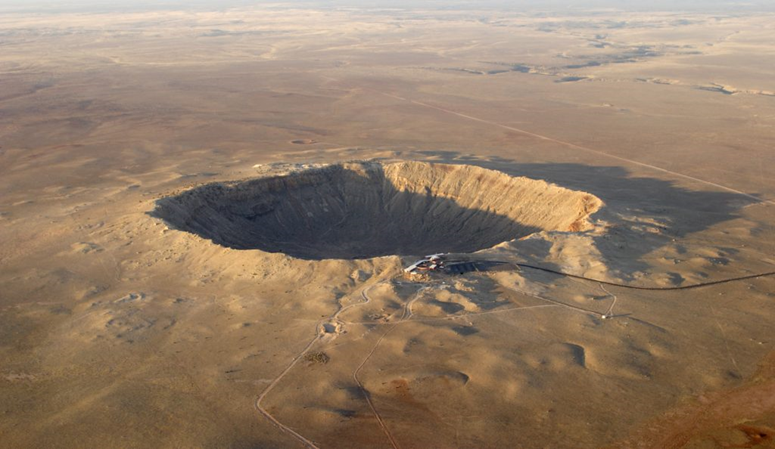Amazing impact craters on Earth shed light on our planet's history

Impact craters occur on every planetary body in our solar system, regardless of its size. By studying impact craters and the meteorites that cause them, we can learn about the processes and geology that make up our entire solar system.
The Earth is constantly being bombarded with space debris. Fortunately, most of it burns up as it enters our atmosphere, but some of it hits the ground, leaving amazing impact craters.
This list contains some of the most interesting impact craters on Earth:
1. Barringer Crater, USA

Barringer Crater, often called "Meteor Crater", is located near Winslow, Arizona, in the United States, and was the first meteor crater confirmed to have been caused by an impact from extraterrestrial bodies.
The diameter of the crater is about one kilometer, and it is about 50,000 years old, which makes it relatively “young”. We have known about the crater since the late 19th century, but there has been debate as to whether it was the result of an impact, or linked to the nearby volcanic province.
It wasn't until the 1960s when high-pressure forms of quartz were identified in rocks, to meteorite fragments found nearby, that scientists could definitively say it was a meteorite impact.
The crater is a site of active research. It is well preserved, making it an excellent place to learn about the impact crash process. Since the early Apollo days, Barringer Crater has also been used to train astronauts. This practice continues to this day, as astronauts learn from the Artemis mission how to navigate terrains like those they would encounter on the Moon, as well as a little bit of geology.
2. Chicxulub Crater, Mexico

This 180-kilometre-diameter crater, located on Mexico's Yucatan Peninsula, is the second largest impact crater on Earth, and has been dated to 66 million years ago - around the time the dinosaurs became extinct.
Geologists have searched for years for mass extinctions recorded in rocks around the world. This did not happen until the discovery of iridium, an element more abundant in meteorites than on Earth, at the site of the meteorite fall.
The diameter of the object that hit the ground was estimated at 10 kilometers, and it was traveling at a speed of 20 kilometers per second. That's about a 5-minute commute from Sydney to Los Angeles.
And it wasn't just the dinosaurs that became extinct, as it is estimated that 75% of the plant and animal species on Earth became extinct as a result of this event.
The impact could have been catastrophic immediately, with aftereffects for decades. There were great tsunamis, and forests burned all over the world. Sunlight was evaporated by ash and gases, perhaps for years, leading to a global winter in which many species perished.
3. Vredefort, South Africa

Crater impacts can be a source of economic resources. For example, an impact can lead to the concentration of minerals present in place before the formation of an impact crater, and this is the case in the Vredefort Structure in South Africa, where it is estimated that more than a third of the world's gold has been extracted from here.
The Vredefort impact structure is the largest confirmed impact crater on Earth, about 2 billion years old. The original crater was thought to be up to 300 kilometers in diameter, but it has been largely eroded.
The impact revealed some of the oldest rocks on the planet. It's one of the very few places where you can see a complete geological record of a massive ancient third of Earth's history, with rocks ranging in age from 2.1 to 3.5 billion years.
4. Tannoralla Crater (Gosses Bluff), Australia

Australia is home to 30 impact craters, and these majestic geological structures are often considered sacred places by local Aboriginal communities.
Gosse's Bluff impact crater is known as "Tnorala" by the people of Western Arrernte.
Today, Tanurala has a diameter of 4.5 kilometers, and is located 150 meters above the surrounding desert, but when it was first formed 142 million years ago, it may have been closer to 24 kilometers in diameter and eroded over time.
5. Nördlinger Ries, Germany

Nördlinger Ries Crater, also known as Ries Crater, formed about 14 million years ago and has a diameter of about 24 km.
The town of Nördlingen lies inside the crater, just south of the center. And if you go up the steeple, you can see the edge of the crater.
Many of the buildings in the city, including the church, were built using rocks formed in the impact.
The crater contains layers of rock and minerals that are better preserved than almost anywhere else on Earth. During impact, the graphite was subjected to very high pressures and temperatures. This pressure turned the graphite into millions of tiny diamonds that dotted the city's buildings.
The impact also impacted a sandy layer of material near the surface, creating glassy-green tektites. Tektites are glass formed when meteorites hit the Earth's surface, and can often be found hundreds or thousands of kilometers from the original impact site.
Source: phys.org

